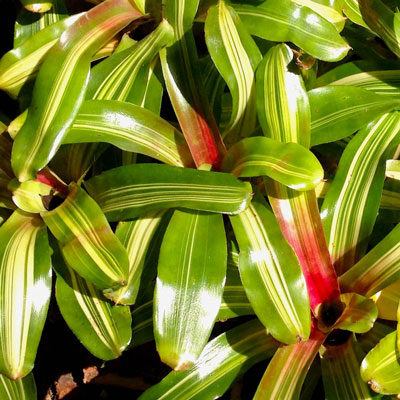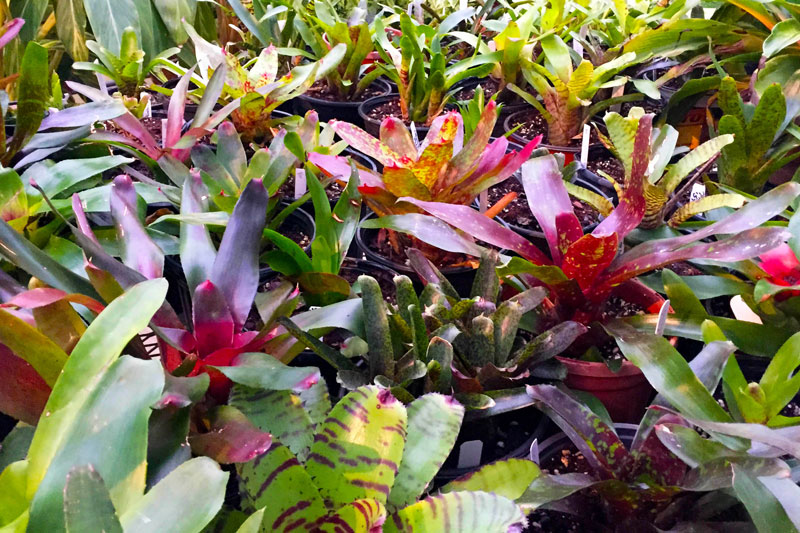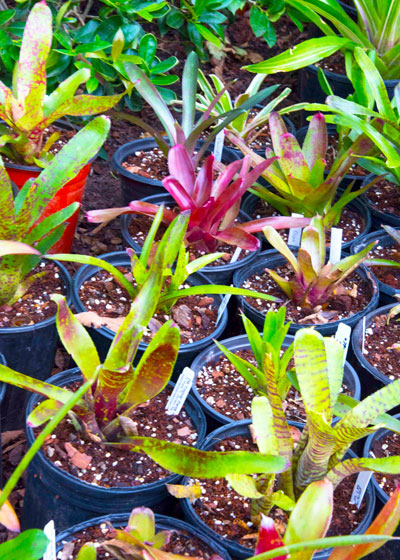Neoregelias in the Sperry gardens
I stumbled onto this great group of bromeliads almost by accident. I’d been growing them for decades, so they certainly weren’t strangers to me or my greenhouse, but I’d never considered them as landscape plants for my gardens.

However, faced with what seemed to be an endless supply of armadillos digging their way through my plantings (in spite of our successful efforts at humane trapping and releasing miles away into a Corps of Engineers flood plain), I noticed that a couple of Neoregelias I had sitting on the ground in wire hanging baskets were going untouched.
Rabbits didn’t eat them. Armadillos didn’t dig around them. Insects and diseases left them alone. They held up to the heat, although they had to come into the greenhouse over the winter. They’re adapted to morning sun until 9 or 10 in the summer (more in spring or fall), and they tolerate shade the rest of the day. They do, however, color up best if they get bright indirect light.

I’m specifically talking about trailing types of Neoregelias, specifically the types that send out stout, short stems and new plants (“pups”) from the mother plants. You’ll hear them called “stoloniferous” in reference to those stems, and you’ll find them grouped as “dwarf” or “mini” Neoregelias.

A Bit of Their Background…
Native homes: Almost all bromeliads are native to Central and South America. Neoregelias are native to eastern Brazil. Almost all are totally tropical, killed by temperatures at, or just below, freezing.
How they grow…
Most bromeliads, Neoregelias included, are epiphytic (as opposed to parasitic). They use their host trees only for support. A few genera of bromeliads are terrestrial, and those tend to be from more arid areas.
How they function:
Since the epiphytic bromeliads, including my Neoregelias, grow off the ground, rainfall drains quickly away from their coarse root systems. In fact, those roots function primarily as anchors to the trees’ trunks. Many bromeliads’ leaves overlap one another to form watertight vases that retain rainfall. Their leaves are structured in a way that the plants can utilize that water to supply their needs.
That doesn’t mean, however, that I grow my Neoregelias in the air. Indeed, I’ve potted them up into 1- and 2-gallon containers. To provide the kind of excellent drainage bromeliads require, I use a potting soil made up of 50 percent sphagnum peat moss, 25 percent pine bark mulch, 15 percent horticultural perlite and 10 percent expanded shale.
When mid-spring arrives each year, I plunge my plants, pots and all, into holes in my color beds. Their leaves and pups conceal the fact that they’re not permanently planted, and I have the ability to adjust and relocate them at any time.


I bought several dozen Neoregelias and other bromeliads several years ago from a handful of growers on eBay. I used the search terms “Neoregelia stoloniferous.” All had 99 percent positive ratings (or better), and all were from the U.S. I’ve bought lots of plants off eBay over the years and I’ve never been stung. Just read the details carefully before you buy.
